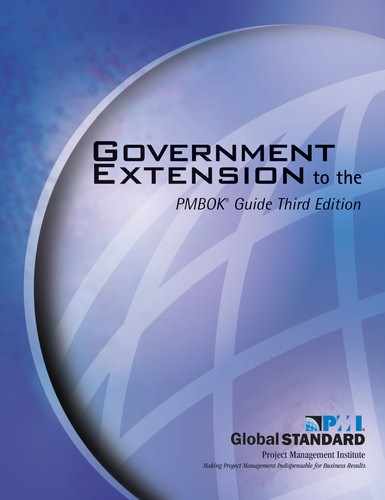Appendix B
Evolution of PMI’s Government Extension to the PMBOK® Guide Third Edition
B.1 Initial Development
In October 1998, the Project Management Institute (PMI) Government Specific Interest Group (SIG) appointed Nigel Blampied as project manager to develop a Government Extension. Over the course of the following year, articles were published in the SIG newsletter both to recruit team members and to begin a discussion on the features that make government projects unique.
A project work breakdown structure was prepared in September 1999; the PMI Standards Member Advisory Group approved a project charter in January 2000 establishing the Government Extension Project as a PMI Standards Project.
The team began to assemble in August 1999, mainly in response to articles in the SIG newsletter. All team members were volunteers, and they came from eight countries. The team included project managers from all spheres of government (national, regional, and local) and from several fields, including agriculture, education, energy, health and human services, labor, and transportation.
Each team member was asked to join one or more of the twelve chapter teams, and a lead author was assigned to each chapter. Lead authors were responsible for the successful completion of a particular chapter and wrote the first draft of the chapter. Co-authors contributed ideas and text to the chapter.
Draft 1 of each chapter was submitted to the full team as it was completed, between July and November 2000. The team evaluated 123 proposed amendments and approved 91 amendments.
In December 2000, Draft 2 was submitted to all members of the Government SIG with known email addresses. SIG members responded with 173 recommended amendments. A core team evaluated these proposed amendments, approved 153 and decided that 20 were unpersuasive. Draft 2 with the 153 amendments became Draft 3.
Draft 3 was reviewed by the PMI Standards Program Member Advisory Group and a panel of Subject Matter Experts (SME) in July 2001. The panel reviewed the draft and proposed thirteen specific amendments. Draft 3 with the eleven amendments became Draft 4, the exposure draft. The PMI Standards Program Member Advisory Group sent the draft and the SME comments back to the team and requested the team consider how to handle each comment and recommendation.
Under the auspices of the PMI Standards Program, PMI published the exposure draft on the PMI Web site on 19 October 2001. Comments were received until 21 December 2001. A total of 95 recommended amendments were submitted. A core team evaluated these proposed amendments, approved 67, adopted 17 in a modified form and decided that 11 were unpersuasive. Draft 4 with the 84 amendments became the final draft. The project team submitted their final draft to the PMI Standards Manager in March 2002 for review and recommendation by the PMI Standards Program Member Advisory Group to publish as a PMI Standard.
B.2 2004–2005 Update
On April 29, 2004 the PMI Standards Program chartered a project to produce a second edition of the Government Extension. Peter Dimov, PMP, was appointed as project manager. Whereas the first edition aligned with the A Guide to the Project Management Body of Knowledge—2000 Edition (PMBOK® Guide—2000 Edition), the second edition was to align with A Guide to the Project Management Body of Knowledge—Third Edition (PMBOK® Guide—Third Edition).
A 35-member team began to assemble in spring–summer 2004. Team members are listed in Appendix C. All team members are volunteers, and they come from all spheres of government—national, regional, and local—and from a large number of industries.
Team members joined one or more of ten teams: Core Team; Communications; Membership; Process Definition and Lessons Learned; PMBOK® Guide—Third Edition Alignment and Additions; Editorial and Writing, Glossary; Comments; Government Review; and Product Review. The PMBOK® Guide—Third Edition Alignment and Additions, the principal development team, was further sub-divided into twelve sub teams, one for each chapter.
The Core Team met in Washington DC for two days in late August 2004, reviewed the differences between the 2000 Edition and the Third Edition of the PMBOK® Guide. The project manager and a core team member from the team participated in this review. The Core Team considered how the PMBOK® Guide changes might affect the Government Extension. This led to an initial list of probable changes.
Building on the work of the Core Team, each chapter sub-team brainstormed recommended changes. In September 2004 they produced the first list of changes, which was reviewed by the PMBOK Alignment and Additions team. In November and December 2004 each chapter sub-team further detailed the approved changes. The first draft, incorporating the agreed changes, was produced in January 2005.
The entire GEU team reviewed the first draft to ensure consistency between chapters. The Core Team met in February 2005 to analyze the first draft and the team’s observations. The first draft with the updates produced by the Core Team became a second draft, which was submitted to the PMI Standards Program Manager.
After a review by the PMI Standards Program Member Advisory Group, the second draft was submitted to a panel of Subject Matter Experts (SME). The panel reviewed the draft, gave it a positive review, and recommended that it proceed to the exposure draft. Panel members proposed 43 amendments, and the team incorporated 27 of these into the document. Draft 2 with the amendments became the exposure draft.
Under the auspices of the PMI Standards Program, PMI published the exposure draft on the PMI Web site in July 2005. Comments were received until 12 September 2005. A total of 133 recommended amendments were submitted. The chapter teams evaluated these proposed amendments, accepted 105, accepted 23 with modifications, deferred 1, and decided that 4 were not accepted. The exposure draft with the 128 amendments became the final draft.
The project team submitted their final draft to the PMI Standards Manager in February 2006 for review and recommendation by the PMI Standards Program Member Advisory Group to publish as a PMI Standard.
